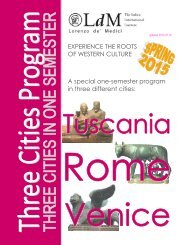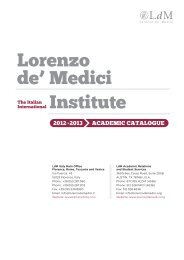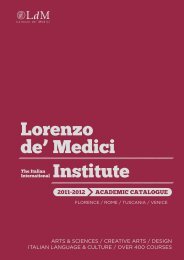aCademiC Catalog 2013-2014 - Lorenzo de Medici
aCademiC Catalog 2013-2014 - Lorenzo de Medici
aCademiC Catalog 2013-2014 - Lorenzo de Medici
Create successful ePaper yourself
Turn your PDF publications into a flip-book with our unique Google optimized e-Paper software.
School of Arts & Sciences TUSCANIA<br />
Anthropology<br />
Archaeology Field School: Tuscania (Italy)<br />
ANT 282-283 T; Dual listed: CLA 282-283 T / HIS 282-283 T<br />
Cr: 6; Contact hrs: 148<br />
This four-week intensive course in archaeology is held at a<br />
specific site representing a distinctive ancient Mediterranean<br />
culture. The course offers stu<strong>de</strong>nts a unique combination<br />
of supervised on-site fieldwork and specialized aca<strong>de</strong>mic<br />
instruction by archaeologists and other specialists. Participants<br />
contribute to the ongoing excavation and preservation of the<br />
site, learning essential practical archaeological techniques. The<br />
particular civilization represented by the site is analyzed in terms<br />
of its material culture, artistic production, and society (including<br />
political organization, religion, economy, and everyday life). The<br />
course inclu<strong>de</strong>s weekly visits to sites, monuments and museums<br />
of relevance. Participants work alongsi<strong>de</strong> stu<strong>de</strong>nts from the<br />
University of Florence. The course is offered in collaboration<br />
with the Center for Ancient Mediterranean and Near Eastern<br />
Studies (CAMNES). Offered at various sites, including two<br />
sponsored by the <strong>Lorenzo</strong> <strong>de</strong>’ <strong>Medici</strong> Institute. One of the<br />
richest sites for Etruscan culture, Tuscania in northern Latium<br />
is situated in the southern area of the region inhabited by this<br />
people between the 9th to the 1st centuries BCE. Many features<br />
of the site and the wi<strong>de</strong> range of artefacts discovered belong to<br />
later Etruscan culture (Hellenistic period). The course focuses<br />
on Etruscan culture in a period of cosmopolitan expansion and<br />
assimilation to Roman culture. Learning activities may inclu<strong>de</strong><br />
visits to Cerveteri, Tarquinia, and the Museo di Villa Giulia in<br />
Rome. Excavation has been overseen by the University of<br />
Florence, <strong>Lorenzo</strong> <strong>de</strong>’ <strong>Medici</strong> Institute, and CAMNES.<br />
Note: ANT 282 T / CLA 282 T / HIS 282 T is offered also as a<br />
3-Credit (two week) Field School<br />
Archaeology and Classical<br />
Studies<br />
Introduction to Archaeology<br />
CLA 240 T<br />
Cr: 3; Contact hrs: 45<br />
Archaeology attempts to un<strong>de</strong>rstand humankind through the<br />
study of physical remains of past civilizations. This course<br />
introduces stu<strong>de</strong>nts to the aims, methods and possibilities<br />
of archaeological work, from the field to the museum,<br />
exploring past and recent theories and approaches to the<br />
discipline. Key issues in the practice of mo<strong>de</strong>rn archaeologists<br />
are examined, some through case studies. Topics inclu<strong>de</strong><br />
excavation, stratigraphy, cleaning and preservation, dating<br />
methods and protection of cultural heritage. Stu<strong>de</strong>nts study<br />
how archaeologists refer to other disciplines including history,<br />
cultural and physical anthropology, and art history. The course<br />
consi<strong>de</strong>rs contexts of both ancient Mediterranean and Near<br />
Eastern archaeology, from Prehistory to the Roman Empire,<br />
and inclu<strong>de</strong>s visits to museums and archaeological sites.<br />
Etruscan and Roman Civilizations<br />
CLA 245 T<br />
Cr: 3; Contact hrs: 45<br />
This course presents a survey of the extraordinarily rich<br />
civilizations that thrived in Central Italy, where Tuscania<br />
flourished, from the 8th century BCE to the 5th century CE.<br />
Stu<strong>de</strong>nts will discover the political, social, cultural and religious<br />
dimensions of the Etruscan and Roman cultures, engaging with<br />
surviving art, architecture and literature. We’ll discover together<br />
their customs and daily life starting from the analysis of the<br />
remaining archaeological evi<strong>de</strong>nce. Key issues in the practice<br />
of mo<strong>de</strong>rn archaeology are explored through the use of case<br />
studies relating to the town of Tuscania and its surroundings<br />
(Tuscia), an area of exceptional archaeological interest and<br />
very rich in ancient history. Site visits enforce what the stu<strong>de</strong>nts<br />
have learned in class and enhance the un<strong>de</strong>rstanding of these<br />
past cultures.<br />
Archaeology Field School: Tuscania (Italy)<br />
CLA 282-283 T; Dual listed: ANT 282-283 T / HIS 282-283 T<br />
Cr: 6; Contact hrs: 148<br />
This four-week intensive course in archaeology is held at a<br />
specific site representing a distinctive ancient Mediterranean<br />
culture. The course offers stu<strong>de</strong>nts a unique combination<br />
of supervised on-site fieldwork and specialized aca<strong>de</strong>mic<br />
instruction by archaeologists and other specialists. Participants<br />
contribute to the ongoing excavation and preservation of the<br />
site, learning essential practical archaeological techniques. The<br />
particular civilization represented by the site is analyzed in terms<br />
of its material culture, artistic production, and society (including<br />
political organization, religion, economy, and everyday life). The<br />
course inclu<strong>de</strong>s weekly visits to sites, monuments and museums<br />
of relevance. Participants work alongsi<strong>de</strong> stu<strong>de</strong>nts from the<br />
University of Florence. The course is offered in collaboration<br />
with the Center for Ancient Mediterranean and Near Eastern<br />
Studies (CAMNES). Offered at various sites, including two<br />
sponsored by the <strong>Lorenzo</strong> <strong>de</strong>’ <strong>Medici</strong> Institute. One of the<br />
richest sites for Etruscan culture, Tuscania in northern Latium<br />
is situated in the southern area of the region inhabited by this<br />
people between the 9th to the 1st centuries BCE. Many features<br />
of the site and the wi<strong>de</strong> range of artefacts discovered belong to<br />
later Etruscan culture (Hellenistic period). The course focuses<br />
on Etruscan culture in a period of cosmopolitan expansion and<br />
assimilation to Roman culture. Learning activities may inclu<strong>de</strong><br />
visits to Cerveteri, Tarquinia, and the Museo di Villa Giulia in<br />
Rome. Excavation has been overseen by the University of<br />
Florence, <strong>Lorenzo</strong> <strong>de</strong>’ <strong>Medici</strong> Institute, and CAMNES.<br />
Note: CLA 282 T / ANT 282 T / HIS 282 T is offered also as a<br />
3-Credit (two week) Field School<br />
Ancient Mediterranean Civilization<br />
CLA 294 T; Dual listed: HIS 294 T<br />
Cr: 3; Contact hrs: 45<br />
This course presents a survey of the extraordinarily rich<br />
civilizations that thrived in Italy and the Mediterranean from the<br />
8th century BCE to the 5th century CE. Stu<strong>de</strong>nts investigate<br />
the political, social, cultural and religious dimensions of the<br />
Greek, Roman and Etruscan civilizations, engaging with<br />
surviving literature, art and architecture. Themes covered<br />
may inclu<strong>de</strong>: the principal historical <strong>de</strong>velopments; political<br />
trends in the Mediterranean world; classical literature;<br />
major issues in philosophy; spirituality and cults; cultural<br />
and commercial exchange in the Mediterranean. Site visits<br />
enhance un<strong>de</strong>rstanding of the chronology and the enduring<br />
achievements of ancient Mediterranean culture.<br />
Archaeology of Italy: from Constantine to<br />
Charlemagne<br />
CLA 298 T<br />
Cr: 3; Contact hrs: 45<br />
Once dismissed as the “Dark Ages” of invasion and <strong>de</strong>struction<br />
between the fall of ancient Rome and the rise of the medieval<br />
communes, the period has become the focus of intense<br />
scholarly activity and <strong>de</strong>bate. Thanks to excavations in towns,<br />
villas, cemeteries, churches and castles, a vastly more dynamic<br />
picture has emerged for Italy from Late Antiquity and the Early<br />
Middle Ages (circa 300-1000 CE). Exploiting new data and<br />
finds, together with secondary studies and literary sources,<br />
this course offers an overview of the archeological evi<strong>de</strong>nce<br />
and history of one of the most vital and complex periods in<br />
all European history. The stress is on continuity and major<br />
changes that occurred in the peninsula after the collapse of<br />
the Western Roman Empire. The medieval remains in Rome<br />
and northern Latium are outstanding. Course topics inclu<strong>de</strong>:<br />
archaeology of various typologies (domestic, settlements,<br />
churches, monasteries, burials, <strong>de</strong>fensive structures); specific<br />
cultures (Ostrogoths, Lombards); inscriptions; conservation<br />
and reconstruction; distinctive object types; basic analytical<br />
methods of various materials (pottery, metal, glass, wood,<br />
stone). Activities inclu<strong>de</strong> visits to museums in Rome and<br />
Tuscania (special laboratory), and to two excavation sites.<br />
The Age of the Heroes: Iliad, Odyssey, Aeneid,<br />
and the Origins of Western Literature<br />
CLA 306 T; Dual listed: LIT 306 T<br />
Cr: 3; Contact hrs: 45<br />
The course is a general overview of ancient literature through<br />
the analysis and comparison of some of the ol<strong>de</strong>st works of<br />
Western civilization. Through a reading of the most significant<br />
160<br />
LdM Aca<strong>de</strong>mic <strong>Catalog</strong> <strong>2013</strong>-<strong>2014</strong>





